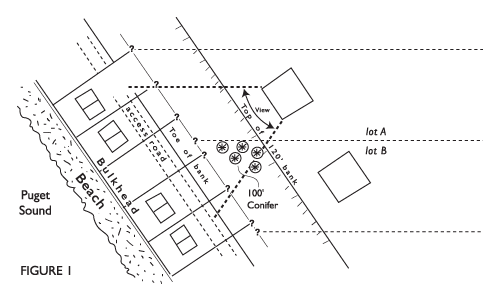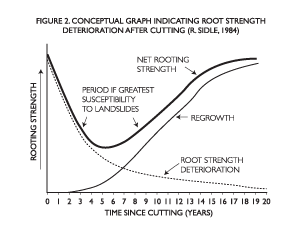Tree Removal on Steep Slopes of Puget Sound Shorelines
The mechanical and hydrogeological benefits which trees and other vegetation provide to maintain slope stability and reduce erosion are well documented. Most of the wooded bluffs rimming Puget Sound are in a delicate equilibrium. For example, natural events such as an unusually intense winter rainstorm or human activities such as a concentration of upland runoff or careless logging on the bluff can reduce stability, even trigger landslides. As a planner or permitting agency official, what are your responsibilities regarding tree cutting? Given that there may be downslope impacts, possibly serious hazards to homes or public facilities, do you make decisions regarding tree cutting and/or removal? If so, remember the admonition to physicians: “First, do no harm.”
Let’s assume that trees have already been cut and downslope residents voice concerns about effects on bank stability. Some questions that may arise:
- Was the cutting authorized by your agency or another agency (e.g., DNR) that has jurisdiction?
- Who owns the land? Property side lines on waterfront/view lots are commonly skewed (Fig. 1). Property boundaries on the face of a bluff are commonly unmarked or inaccessible.
- Who cut the trees or hired the cutter? Timber trespass is not uncommon in such settings. Has a timber trespass occurred?

Property ownership and cutting responsibility questions are basic to questions of log removal/leave and slope rehabilitation/replanting. As our main focal point here is on removal, an obvious question arises: Who pays for it? A property owner who cuts his or her own trees (after obtaining necessary permits, if any) is obviously responsible for such decisions. What about the rather common situation in such settings of ‘timber trespass”? In at least some situations the owner is entitled to triple damages from the illegal cutter. Will the property owner allow access to the site for removal of the downed trees? If so, will that increase his or her liability for accidents or some future slide from their property? Such legal aspects of the problem are not trivial. Economics, including potential liability, may decide what (if anything) is done regarding tree removal, slope rehabilitation, and revegetation.
Upon what can ‘damages” for trespass be based? The value of a tree for lumber can be calculated rather precisely on the basis of market factors such as species, size, cost to reach market, and current price. What about aesthetic value? (Some arborists and/or real estate professionals may be able to offer an estimate of the impact of the loss of the trees on property value.) The value of an individual tree or group of trees in relation to their role in maintaining slope stability is even more difficult to quantify, but it is often a significant consideration.
Let’s assume that the trees were cut with city or county permission. Assume that the loss of trees will have some detrimental effect on slope stability, both immediately (precipitation interception, transpiration) and long term (loss of root/soil reinforcement, anchoring over time). Assume that the potential for any damage resulting from the instability (e.g., landslides) will be increased by the presence of large woody debris left on the slope. As the planner in the Permit Center who signed off on the cutting, should you insist on removal of the cut trees? (Hint: This slope may slide anyway, whether the logs are removed or not.)
As mentioned, the loss of mature or at least well-established trees has a significant effect on the stability of already marginal slopes. Soil disturbance and the further loss of young trees and brush, as well as the forest floor duff and litter, can further degrade stability. Log removal efforts can seriously disrupt shallow soils and such ground cover. Thus we are faced with two major options: leave the trees where they fell or remove them. Either choice can impact slope stability and legal liability. Logs can be removed with little or no further disturbance of soil and ground cover by what loggers and commercial foresters call “full suspension” techniques.
Logs are lifted, not dragged. This requires specialized heavy equipment both at the top and bottom of a slope (or at least a strong “block” or pulley with a massive anchor at one end). Full suspension can also be achieved by balloons or large helicopters. All such techniques are very expensive and/or impractical or impossible to use in most populated shoreline bluff settings. The ‘reach’ of a crane from the top or from the base of a bluff is limited, even where such sites are accessible; they are almost useless on bluffs in the 150- to 300-ft range.
Horse logging can minimize soil and underbrush disturbance, but cannot be done on slopes as steep as most of our shoreline bluffs. Tractors and excavators need roads on such slopes, and the logs still must be dragged to the road. Also, the roads themselves leave unstable slopes as well as concentrate storm runoff long after the logging is complete. Thus by process of elimination, we are left with hand labor for removing large woody debris from most steep coastal bluffs.
Assuming that hand labor is the only practical option for removal of downed timber from steep (35+ degree) slopes, let’s consider its limitations.
- It is dangerous, hard work, even for the experienced.
- Thus, experienced help can be expensive.
- Amateur do-it-yourself help can be more expensive (i.e., medical, liability)
- There is a limit to the size of material that can be handled (excluding help from gravity, which we are trying to avoid)
Some ways we can minimize these limitations are:
- If there is no hazard (people, structures) below, reconsider. Maybe the logs should be left in place; let nature take its course (i.e., rot and gravity)
- Leave wood in contact with the ground, if possible, to facilitate rotting.
- Work when spring slide hazard is past; remove wood in early fall.
- If a log is oriented within 20 degrees or so of perpendicular to the slope and is supported by a sprouting stump at both ends, leave it.
- Cut (and split?) a log into sizes that can be manhandled.
- Leave tops and limbs smaller than 3- to 4-in. diameter scattered on the slope as ground cover.
- Do not pile tops/limbs, as piles can prevent regrowth (natural or planted) and smother native brush.
In precarious areas directly above a residence, hazards can be minimized by common-sense techniques such as tying a downed tree to a stump before cutting it into logs. Temporary ‘cyclone fences’ can be strung between standing trees above the downslope home. Experienced woodsmen (for example, cedar cutters) can move wood in ingenious ways with little equipment. Don’t try to “fine tune” their plan; every situation of trees, topography, and potential hazard is unique. Perhaps the best conditional constraint would be that no additional disturbance to the slope should occur.
Before ordering removal of large downed trees on a steep slope, the planner/permit official might want to check with their legal counsel. What is at hazard downslope? Do homeowners at the base of the bluff understand the options and potential hazards? For example, a “cartwheel” of firewood from a 3- to 4-ft fir can become lethal if it starts rolling on a steep slope. Who is liable? The wood cutter? The property owner? The agency that ordered or approved the removal? All of the above? (An industrial or commercial downslope property owner might want to make their own plans regarding timber cutting/log removal.)
What about stumps? A stump and its rootball, if mobilized into a shallow fast-moving slide (debris avalanche), can add to the future damage potential of the mud and smaller debris. However, removing stumps will increase the likelihood of such events. As the roots of many stumps rot, their ability to provide reinforcement and anchoring of the soil/vegetation mat decreases. However, they may still provide that critical role, albeit to a decreasing extent over time, while new trees are getting established. (See figure 2) Generally, stumps of cut trees should not be removed.

Special mention is warranted for stumps that sprout, thus keeping the stump alive and its roots functioning. Species such as maple, willow, and madrone usually sprout and, after several years, may provide the same slope stabilizing benefits as the standing tree. It is not unusual to see cut-over slopes slide except for the area at and below a single sprouted maple stump. Also, removing a stump on a bluff via hand labor is slow and expensive and creates a bare patch subject to erosion and increased infiltration. Except in isolated instances where a stump is an obvious hazard, they should be left.
If you need to remove large (1-ft+) trees from an area of steep ground (35+ degrees) where property and lives below could be at stake, get a pro. The passing ‘blow-hard’ who can shrug and walk away from his self-created “accident” won’t do. Get a responsible expert (one who is licensed, bonded). That person should be able to tell if a particular site is a ‘piece of cake’ or will require much finesse. If the hazard potential is great, you might want a second opinion. As a public official, with your signature on the application, carefully exploring all options may save you and your agency later grief and expense.
Mitigation of damage to the slope from tree cutting and removal of debris should be a routine condition of permitting tree removals. Mitigation specifications should reduce both short- and long-term stability and erosion impacts which are likely to occur as a result of tree removal. Measures such as revegetation with suitable native species are often effective if an agency requires adequate monitoring and project maintenance during the establishment period (3-5 years). Vegetative buffers at the crest of the slope, as well as drainage controls of upland and slope surface-water run-off are also valuable mitigation tools.
Cutting of trees and removal of large woody debris from steep slopes can impact slope stability and have long-term legal ramifications for landowners and permitting agencies. Caution and common sense should be exercised in managing steep, often unstable, marine slopes.